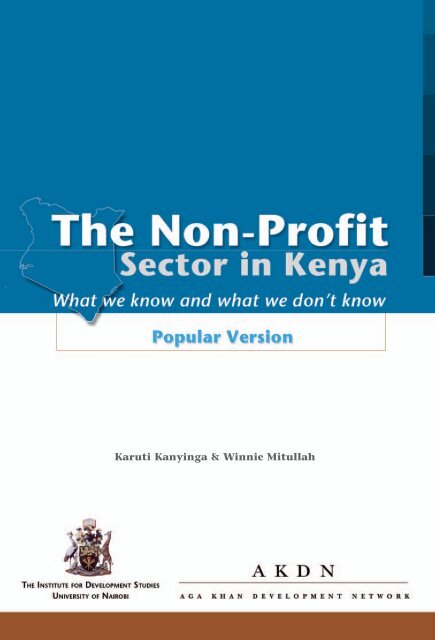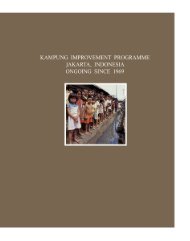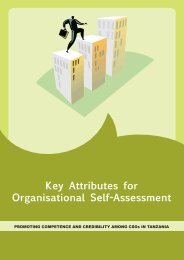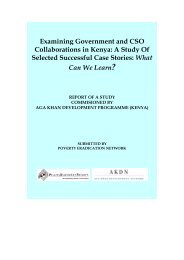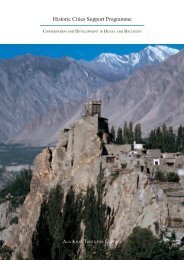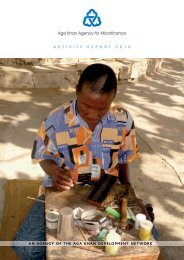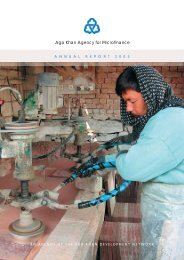The Non-Profit Sector in Kenya - Aga Khan Development Network
The Non-Profit Sector in Kenya - Aga Khan Development Network
The Non-Profit Sector in Kenya - Aga Khan Development Network
- No tags were found...
Create successful ePaper yourself
Turn your PDF publications into a flip-book with our unique Google optimized e-Paper software.
Karuti Kany<strong>in</strong>ga & W<strong>in</strong>nie Mitullah
Published by:<strong>The</strong> Institute for <strong>Development</strong> Studies (IDS)University of NairobiP.O. Box 30197 – 00100GPO Nairobi, <strong>Kenya</strong>Telephone: (+254 – 20) 247968 or 318262Cellphone: 254-733 524903 or 0722 499706Email: director-ids@uonbi.ac.keURL: www.uonbi.ac.ke/faculties/ids© 2007 Institute for <strong>Development</strong> Studies (IDS), University of NairobiISBN: 9966 00 0 0This publication is not for quotation without permission as specified <strong>in</strong>the Copyright Act, Cap. 130 of the Laws of <strong>Kenya</strong>Views expressed <strong>in</strong> this publication are those of the authors and shouldnot be <strong>in</strong>terpreted as reflect<strong>in</strong>g the views of the Institute for <strong>Development</strong>Studies (IDS) of the University of Nairobi
Acknowledgement<strong>The</strong> idea to produce a publication on basic features of the <strong>Non</strong>-<strong>Profit</strong><strong>Sector</strong> <strong>in</strong> <strong>Kenya</strong> evolved from the realisation that past studies have notprovided a comprehensive picture of the sector. <strong>The</strong> lack of <strong>in</strong>formationon the basic features of the sector has contributed to the sectorrema<strong>in</strong><strong>in</strong>g least understood. Not even practitioners <strong>in</strong> the sector areaware about the size, structure and scope of the non-profit sector <strong>in</strong><strong>Kenya</strong>. We embarked on this mission with generous support andadvice of the <strong>Aga</strong> <strong>Khan</strong> <strong>Development</strong> <strong>Network</strong> (Geneva), throughRichard Holloway, the Civil Society Director. We are grateful toRichard, and <strong>Aga</strong> <strong>Khan</strong> <strong>Development</strong> <strong>Network</strong> AKDN, for this.Collection and analysis of data on which this publication is based hasbeen a challeng<strong>in</strong>g task. Many people helped us <strong>in</strong> meet<strong>in</strong>g some ofthese challenges. We may not be able to thank all of them here. We aregrateful to Mr Sebastian Njagi, the Project Assistant, for coord<strong>in</strong>at<strong>in</strong>gcollection of the first set of data and mak<strong>in</strong>g substantive contributionto our writ<strong>in</strong>g. We are <strong>in</strong>debted to Mr Coll<strong>in</strong>s Omondi for assist<strong>in</strong>g <strong>in</strong>updat<strong>in</strong>g some of the data for this publication. Special thanks to MrAmbani Osogo for coord<strong>in</strong>at<strong>in</strong>g the review of outputs and organisationof forums for receiv<strong>in</strong>g comments.We acknowledge the f<strong>in</strong>ancial support provided by both the FordFoundation and the <strong>Aga</strong> <strong>Khan</strong> Foundation <strong>in</strong> the first phase of theproject under the Johns Hopk<strong>in</strong>s Comparative <strong>Non</strong>-<strong>Profit</strong> <strong>Sector</strong>Project. Thanks are due to Lester M. Salamon for his advice through-Acknowledgementsv
out the first phase of the project, and the subsequent contacts andl<strong>in</strong>kages that we cont<strong>in</strong>ue to ma<strong>in</strong>ta<strong>in</strong> with the Johns Hopk<strong>in</strong>s Centrefor Civil Society Studies.We gratefully acknowledge the f<strong>in</strong>ancial support provided by the <strong>Aga</strong><strong>Khan</strong> Foundation to update data and produce this publication. We are<strong>in</strong> particular grateful to Richard Holloway, the Civil Society Director,<strong>Aga</strong> <strong>Khan</strong> <strong>Development</strong> <strong>Network</strong>, who facilitated the development ofthis publication. His advice and expert review of various drafts lead<strong>in</strong>gto this publication is most appreciated; he motivated and encouragedus throughout to see light at the end of the tunnel. Special thanks goto Grace Isharaza (<strong>Aga</strong> <strong>Khan</strong> Foundation, East Africa) for her supportthroughout the period of produc<strong>in</strong>g this publication. Her effort <strong>in</strong>mak<strong>in</strong>g follow ups on many deadl<strong>in</strong>es that slipped through is oneth<strong>in</strong>g we are highly appreciative of.<strong>Non</strong>e of these people, however, bears responsibility for any errors offact or <strong>in</strong>terpretation that this publication may conta<strong>in</strong>. This is ourresponsibility as the authors of this publication.Karuti Kany<strong>in</strong>gaOctober 2007vi<strong>The</strong> <strong>Non</strong>-<strong>Profit</strong> <strong>Sector</strong> In <strong>Kenya</strong>
Preface<strong>The</strong> Institute for <strong>Development</strong> Studies (IDS), University of Nairobi, hasbeen engaged <strong>in</strong> a study to document the size, structure and scope ofthe <strong>Non</strong>-<strong>Profit</strong> <strong>Sector</strong> <strong>in</strong> <strong>Kenya</strong>. <strong>The</strong> project was undertaken under theauspices of the Johns Hopk<strong>in</strong>s Comparative <strong>Non</strong>-<strong>Profit</strong> <strong>Sector</strong> Projectof the Centre for Civil Society Studies (CCSS) at the Johns Hopk<strong>in</strong>sUniversity. This was carried out with fund<strong>in</strong>g from the FordFoundation, East African Regional Office, and the <strong>Aga</strong> <strong>Khan</strong>Foundation.Although f<strong>in</strong>d<strong>in</strong>gs of the IDS <strong>Non</strong>-<strong>Profit</strong> <strong>Sector</strong> have been dissem<strong>in</strong>atedthrough several forums and publications, the IDS, with the assistanceof the <strong>Aga</strong> <strong>Khan</strong> Foundation has found it worthwhile to producea publication to <strong>in</strong>form the general public, policy makers, donors,development practitioners and other stakeholders about the structure,scope, size and f<strong>in</strong>anc<strong>in</strong>g of the sector <strong>in</strong> <strong>Kenya</strong>. <strong>The</strong> IDS hopes thatthis will serve as an important reference po<strong>in</strong>t for studies on the sector<strong>in</strong> <strong>Kenya</strong>. <strong>The</strong>se f<strong>in</strong>d<strong>in</strong>gs, thus, provide an important entry po<strong>in</strong>tto a full understand<strong>in</strong>g of the sector <strong>in</strong> <strong>Kenya</strong>, and further form animportant base document for others wish<strong>in</strong>g to study the sector.In <strong>Kenya</strong>, the last four decades have witnessed significant changes <strong>in</strong>the development space. <strong>The</strong> developmental state occupied much ofthe development space <strong>in</strong> the 1960s and 1970s; the state was the ma<strong>in</strong>eng<strong>in</strong>e of development. Public enterprises led <strong>in</strong> provid<strong>in</strong>g socialdevelopment. This changed from the early 1980s <strong>in</strong> tandem withPrefacevii
Table of ContentsChapter 1: Introduction 1What about the non-profit sector <strong>in</strong> <strong>Kenya</strong>?What this publication is aboutChapter 2: Growth Of <strong>The</strong> <strong>Non</strong>-<strong>Profit</strong> <strong>Sector</strong> In <strong>Kenya</strong> 4Expla<strong>in</strong><strong>in</strong>g growthChapter 3: Size And Scope Of <strong>Non</strong>-<strong>Profit</strong> <strong>Sector</strong> 8Ma<strong>in</strong> features of the sectorOutdistances major <strong>in</strong>dustriesSimilar to other develop<strong>in</strong>g countriesAttracts volunteersHuge membershipMission of improv<strong>in</strong>g the welfare of societyChapter 4: Sources Of Revenue And Expenditure Patterns 16REVENUEFees are the dom<strong>in</strong>ant revenueNGOs are dependent on external donorsSelf help community groups are self reliantEXPENDITUREExpenditure patternsChapter 5:: Conclusions And Policy Implications 23
List of TablesTable 1: Example of non-profit sector organisations <strong>in</strong> <strong>Kenya</strong> 5Table 2: Number of non-profit organisations by seven categories <strong>in</strong> <strong>Kenya</strong>(1997-2005) <strong>in</strong> order of magnitude <strong>in</strong> 2005 7Table 3: Change <strong>in</strong> number of NPOs by seven categories (<strong>in</strong> 1997 and 2005)<strong>in</strong> order of amount of change 7Table 4: Significance of the non-profit <strong>Sector</strong> 10Table 5: NPO employment (paid and volunteers) by ICPNO 10Table 6: <strong>Non</strong>-profit workforce as a share of the economically-activepopulation by different k<strong>in</strong>ds of country 12Table 7: Membership <strong>in</strong> NPOs <strong>in</strong> <strong>Kenya</strong> by ICNPO category 14Table 8: Mission of non-profit organisations 15Table 9: Sources of revenue by fields 19Table 10: NGOs sources of fund<strong>in</strong>g 21List of FiguresFigure 1: Overview of annual growth of NPOs (1997 and 2005) 8Figure 2: <strong>The</strong> <strong>Kenya</strong> non-profit sector workforce <strong>in</strong> context 11Figure 3: Distribution of paid employees and volunteers between serviceand expressive activities <strong>in</strong> <strong>Kenya</strong> 12Figure 4: Volunteers as a share of the sector workforce, <strong>Kenya</strong>, develop<strong>in</strong>gand transitional countries, and 36 countries 13Figure 5: Distribution of NGOs by sector <strong>in</strong> 2006 15Figure 6: Sources of non-profit sector fund<strong>in</strong>g 17Figure 7: Sources of non-profit revenue, <strong>Kenya</strong> and elsewhere 18Figure 8: Sources of non-profit revenue <strong>in</strong> <strong>Kenya</strong> by field 20Figure 9: Sources of revenue <strong>in</strong>clud<strong>in</strong>g volunteers 21Figure 10: NPOs expenditure by field 22
IntroductionIt is widely recognised across the world, <strong>in</strong>clud<strong>in</strong>g <strong>Kenya</strong>, that the lasttwo and half decades have witnessed unprecedented growth <strong>in</strong> numberand activities of private non-governmental <strong>in</strong>stitutions. Some havedescribed this growth as a ‘global associational revolution’. Some ofthese organisations were formed to complement state services <strong>in</strong>response to the decl<strong>in</strong><strong>in</strong>g capacity of the state to carry out development.Some were formed to provide alternatives to the state <strong>in</strong> education,<strong>in</strong> protect<strong>in</strong>g the environment, <strong>in</strong> health, economic activities, <strong>in</strong>improv<strong>in</strong>g local water systems, and generally <strong>in</strong> improv<strong>in</strong>g humanwelfare and development.Different terms have been used to def<strong>in</strong>e these organisations. In thispublication, the term <strong>Non</strong>-<strong>Profit</strong> Organisations (NPOs) is used <strong>in</strong> general.<strong>The</strong> term refers specifically to organisations that are private,organised, not primarily commercial (non-profit distribut<strong>in</strong>g to directorsor owners), self-govern<strong>in</strong>g, and voluntary.What about the non-profit sector <strong>in</strong> <strong>Kenya</strong>?<strong>Kenya</strong> has not been exempt from this ‘global revolution’. From thelate 1980s, the country has witnessed <strong>in</strong>creased proliferation of organisationscarry<strong>in</strong>g out non-profit work. <strong>The</strong> last three decades have witnessedunprecedented growth <strong>in</strong> number and activities of these organisations.<strong>The</strong> volume of resources controlled by the sector has alsogrown, if activities carried out by non-profits are anyth<strong>in</strong>g to go by.Chapter 1 Introduction 1
<strong>The</strong> non-profit sector <strong>in</strong> <strong>Kenya</strong> comprises a very diverse group<strong>in</strong>g oforganisations rang<strong>in</strong>g from small welfare and community-based orlocalised traditional welfare associations, to large and secular socialeconomicorganisations. In this study, we have divided NPOs <strong>in</strong>to severaldifferent categories. <strong>The</strong>se are: <strong>Non</strong>-Governmental Organisations(NGOs); Community Based Organisations and Self-Help Groups,<strong>in</strong>clud<strong>in</strong>g women and youth groups; Unions; Cooperatives;Foundations; and Trusts.Table 1: Example of non-profit sector organisations <strong>in</strong> <strong>Kenya</strong>Category of NPO Examples of <strong>Kenya</strong>n organisations <strong>in</strong> each categoryNGOsCooperativesFoundations/TrustsUnionsCommunity BasedOrganisations andSelf-Help Groups(Women GroupsYouth Groups)Undugu Society of <strong>Kenya</strong>, Maendeleo ya Wanawake, WorldVision, Plan International,Marua Cooperative Society, Yala Dairy Cooperative Society,Durasi Hous<strong>in</strong>g Cooperative Society, <strong>Kenya</strong> Small Tradersand Entrepreneurs SocietyHeart to Heart Foundation, Africa Wildlife Foundation,Chandaria Foundation, <strong>Kenya</strong> Gatsby Charitable Trust,Ratansi Educational Trust, Muslim Civic Education TrustMachakos Cooperative Union, Wamuyu HandcraftCooperative Union, Seamen Union of <strong>Kenya</strong>, LocalGovernment Workers Union, <strong>Kenya</strong> National Union ofTeachers, <strong>Kenya</strong> Nut Growers UnionMj<strong>in</strong>i Women Group, Mathare Youth Sports Association,Tharaka Welfare Association, Woodley Welfare Association.Boro Community Based <strong>Development</strong> Women Group,Thungari Self Help Group,Although NPOs have grown <strong>in</strong> number, diversity of activities, and <strong>in</strong>importance for foster<strong>in</strong>g social change, we do not have sufficient dataabout them to improve our knowledge on their capability for development<strong>in</strong> <strong>Kenya</strong>. <strong>The</strong>re are no systematic studies determ<strong>in</strong><strong>in</strong>g whattheir capabilities really are. Furthermore, there is little systematic<strong>in</strong>formation on their basic features. In particular, not much knowledgehas been generated about the actual size, scope and structure of the<strong>Kenya</strong>n NPOs.2<strong>The</strong> <strong>Non</strong>-<strong>Profit</strong> <strong>Sector</strong> In <strong>Kenya</strong>
What this publication is about<strong>The</strong> primary aim of this publication is to set the stage for deepen<strong>in</strong>gour knowledge of the non-profit sector <strong>in</strong> <strong>Kenya</strong>. It conta<strong>in</strong>s figures onthe growth, scope of activities, revenue and expenditure patterns ofNPOs.This publication is based on f<strong>in</strong>d<strong>in</strong>gs of a study conducted <strong>in</strong> collaborationwith Johns Hopk<strong>in</strong>s <strong>Non</strong>-<strong>Profit</strong> <strong>Sector</strong> Project <strong>in</strong> the periodbetween 2000 and 2001, and updated where possible. It is producedwith support from the <strong>Aga</strong> <strong>Khan</strong> Foundation.This is a popular version of a longer document titled “<strong>The</strong> <strong>Non</strong>-<strong>Profit</strong><strong>Sector</strong> <strong>in</strong> <strong>Kenya</strong> – Size, Scope and F<strong>in</strong>anc<strong>in</strong>g” also available from theInstitute for <strong>Development</strong> Studies (IDS) of the University of Nairobi.Chapter 1 Introduction 3
Growth of <strong>The</strong> <strong>Non</strong>-<strong>Profit</strong> <strong>Sector</strong><strong>in</strong> <strong>Kenya</strong><strong>The</strong> non-profit sector has witnessed a huge growth rate throughoutthe post-colonial period. From a few hundreds at <strong>in</strong>dependence <strong>in</strong>1963, the number has <strong>in</strong>creased to thousands of organisations. Table 2shows the growth <strong>in</strong> the number of non-profit <strong>in</strong>stitutions from 1997to 2005. However, we note that there are difficulties obta<strong>in</strong><strong>in</strong>g accurateand reliable data on the sector. <strong>The</strong> National System of Accountsdoes not have systematic data on non-profits. <strong>The</strong> source of datareported here <strong>in</strong>cludes adm<strong>in</strong>istrative records of various m<strong>in</strong>istries,and it is difficult to ascerta<strong>in</strong> if they are complete and accurate.A review of records for the period between 1997 and 2005 reveals thatthere were about 350,000 ‘registered’ non-profit organisations (NPOs)<strong>in</strong> the country <strong>in</strong> 2005. This figure <strong>in</strong>cludes those registered under differentlaws and different m<strong>in</strong>istries.4<strong>The</strong> <strong>Non</strong>-<strong>Profit</strong> <strong>Sector</strong> In <strong>Kenya</strong>
Table 2: Number of non-profit organisations by seven categories <strong>in</strong><strong>Kenya</strong> (1997-2005) 1 <strong>in</strong> order of magnitude <strong>in</strong> 20051997 1998 1999 2002 2003 2004 2005Self-help Groups16,20817,80518,65146,28891,139157,458185,722Women Groups85,20597,317107,080122,441127,951133,135135,294Youth Groups3,4263,7654,2835,5389,97810,94511,083Cooperatives7,5008,6699,1519,92810,20410,54610,867NGOs8368311,2542,2802,7893,1854,099Foundations/Trusts171718231212231223Unions67687089939699TOTAL113,259128,472140,507186,795172,375315,596347,387Source: Adm<strong>in</strong>istrative records of various government agencies/departments(exclud<strong>in</strong>g 2000 and 2001 whose records were <strong>in</strong>complete).As can be seen, the largest number of NPOs are Self-help Groups, andWomen Groups. <strong>The</strong>se are much more numerous than the other categories.<strong>The</strong> actual number of NPOs could be well above this figure becausethere is no systematic way of obta<strong>in</strong><strong>in</strong>g data on youth groups and selfhelpgroups. Some of the districts have not been provid<strong>in</strong>g headoffices with accurate data on annual registration of these groups.Furthermore, there are many groups that are operat<strong>in</strong>g without registrationunder any of the legal and adm<strong>in</strong>istrative regimes. <strong>The</strong>segroups, however, fit the criteria of NPOs <strong>in</strong> many respects. <strong>The</strong> figures,therefore, are <strong>in</strong>dicative of what is go<strong>in</strong>g on, but do not tell the wholestory on the size of the sector. <strong>The</strong>y are, nonetheless, used here to givean idea about the direction of growth of the sector.1 Data for 2000 and 2001 is miss<strong>in</strong>g because of gaps <strong>in</strong> the records of different governmentdepartments. Moreover, no m<strong>in</strong>istries have any data on organisations that ceased to exist.Chapter 2 Growth of <strong>The</strong> <strong>Non</strong>-<strong>Profit</strong> <strong>Sector</strong> <strong>in</strong> <strong>Kenya</strong> 5
Table 3: Change <strong>in</strong> number of NPOs by seven categories (<strong>in</strong> 1997 and2005) <strong>in</strong> order of amount of change1997 2005 % changeFoundations/Trusts172231311Self-help Groups16,208185,7221145NGOs8364099490Youth Groups342611,083323Women Groups85,205135,294159Unions6799147Cooperatives750010,867144TOTAL113,259347,387307As Table 3 shows, the number of NPOs <strong>in</strong>creased threefold over a periodof eight years. Foundations/Trusts <strong>in</strong>creased 13 times, Self-helpgroups <strong>in</strong>creased 11 times, NGOs <strong>in</strong>creased 5 times, and Youth groups<strong>in</strong>creased 3 times.Figure 1: Overview of annual growth of NPOs (1997 and 2005)35%30%25%20%15%10%5%0 1997 - 8 1998-92003-04 2004-05Period (years)Figure 1 shows that the highest growth <strong>in</strong> number of NPOs was <strong>in</strong> the2003-2004 period. This is also the period that witnessed the highestgrowth <strong>in</strong> number of Foundations/Trusts and Self-help Groups. Given6<strong>The</strong> <strong>Non</strong>-<strong>Profit</strong> <strong>Sector</strong> In <strong>Kenya</strong>
that this is the period when a new government came to power, it ispossible that the growth was the result of a new political environment.Expla<strong>in</strong><strong>in</strong>g growthSeveral factors account for the growth of NPOs <strong>in</strong> <strong>Kenya</strong>. First is thecountry’s rich tradition of philanthropy and volunteerism, with roots<strong>in</strong> the communal relationships of an African society. Harambee (pool<strong>in</strong>gtogether of resources to provide basic services) is an expression ofthis tradition and the spirit of volunteerism. This tradition has valuesthat are the foundation of non-profit <strong>in</strong>itiatives <strong>in</strong> the country today.Secondly, until very recently, the capacity of the state to provide basicservices has been on the decl<strong>in</strong>e ow<strong>in</strong>g to sluggish economic growth.When growth was high <strong>in</strong> the 1960s and 1970s, <strong>Kenya</strong> had a developmentalstate that was at the centre of service provision. Poor growth <strong>in</strong>the 1980s and donor conditionalities occasioned the <strong>in</strong>troduction ofStructural Adjustment Programmes. <strong>The</strong>se subsequently reduced thegovernment’s ability to provide services. NPOs filled the gaps <strong>in</strong> serviceprovision throughout the 1990s.Thirdly, though not <strong>in</strong> relation to all the different k<strong>in</strong>ds of non-profits,poor economic management and governance resulted <strong>in</strong> donorsshift<strong>in</strong>g their attention and <strong>in</strong>creas<strong>in</strong>g fund<strong>in</strong>g to NGOs from the early1990s. Increased disbursements through NGOs led to the mushroom<strong>in</strong>gof NGOs, who <strong>in</strong> turn used local community organisations as theirentry po<strong>in</strong>t for development work at the grassroots. This resulted <strong>in</strong>proliferation of organisations <strong>in</strong> the development space.F<strong>in</strong>ally, the com<strong>in</strong>g to power of a new government <strong>in</strong> 2003 evolved anew political environment for registration of organisations. <strong>The</strong> highnumbers of Foundations, Trusts and Self-help Groups were registeredespecially dur<strong>in</strong>g the 2003-2004 period.Chapter 2 Growth of <strong>The</strong> <strong>Non</strong>-<strong>Profit</strong> <strong>Sector</strong> <strong>in</strong> <strong>Kenya</strong> 7
Size and Scope Of <strong>Non</strong>-<strong>Profit</strong> <strong>Sector</strong><strong>The</strong> non-profit sector is a significant economic force <strong>in</strong> <strong>Kenya</strong>. In2000, the sector accounted for about US$270 million <strong>in</strong> expenditure.This was equivalent to 2.5 percent of the Gross Domestic product(GDP), whose significance is illustrated <strong>in</strong> Table 4.Table 4: Significance of the non-profit <strong>Sector</strong>US$ 269.7 million <strong>in</strong> expenditure <strong>in</strong> 2006 2.5% of the <strong>Kenya</strong> Gross Domestic Product (GDP)Represent<strong>in</strong>g:<strong>The</strong> equivalent of 177,075 full time paid employees<strong>The</strong> equivalent of 113,873 full time volunteers2.1% of the economically-active population16.3% of those not employed <strong>in</strong> agriculture42.6% of those employed by the public sectorSource: Organisational surveyIn carry<strong>in</strong>g out their activities, NPOs engage labour on a full time, parttime and volunteer basis. In 2000, the sector had a workforce (bothpaid and volunteer) equivalent to over 290,000 full time workers. Thiswas equivalent to 2.1 percent of <strong>Kenya</strong>’s economically-active population,and 16.3 percent of its non-agricultural employment.8<strong>The</strong> <strong>Non</strong>-<strong>Profit</strong> <strong>Sector</strong> In <strong>Kenya</strong>
We can break this <strong>in</strong>formation down by look<strong>in</strong>g at the sub-sectors <strong>in</strong>which the NPO labour works. This is listed under the categories of theInternational Classification of <strong>Non</strong>-<strong>Profit</strong> Organisations (see Annex 1:Ma<strong>in</strong> NPO Fields and Activities by ICNPO).Table 5: NPO employment (paid and volunteers) by ICPNOICPNO Paid employment VolunteersNo % No %Culture & recreation7,0962.06,4916.3Education & research20,9625.810,0609.8Health7,3502.010,0089.8Social services223,97062.014,29414.0Environment7,8422.23,6563.6<strong>Development</strong> & hous<strong>in</strong>g33,7299.324,12523.6Civic and advocacy9,4342.65,6595.5Philanthropy6360.21670.2International activities00.000.0Religion2,1550.61,5231.5Professional associations1,8370.52,4012.3Others46,47812.923,88723.4Total361,489100.0102,271100.0Source: Organisational surveyMa<strong>in</strong> features of the sectorOutdistances major <strong>in</strong>dustries<strong>The</strong> non-profit sector employs 43 people for every 100 peopleemployed <strong>in</strong> the public sector. In other words, the sector employsalmost half (43%) as many people as the public sector. It also employsmore people than the major <strong>in</strong>dustries <strong>in</strong> the country – utilities, construction,transport and manufactur<strong>in</strong>g, as shown <strong>in</strong> Figure 2 belowChapter 3 Size and Scope of <strong>Non</strong>-<strong>Profit</strong> <strong>Sector</strong> 9
Figure 2: <strong>The</strong> <strong>Kenya</strong> non-profit sector workforce <strong>in</strong> contextVolunteers and paid staff engage <strong>in</strong> two basic roles: service and expressive.In the service role, they undertake activities <strong>in</strong> education, health,social services, development and hous<strong>in</strong>g. In the expressive role, theyundertake activities <strong>in</strong> culture/recreation, professional work, unionwork, civic activities, advocacy, and the environment.In <strong>Kenya</strong>, both paid staff and volunteers work much more <strong>in</strong> the serviceactivities than expressive activities. This is common <strong>in</strong> many develop<strong>in</strong>gand transitional countries. <strong>The</strong> ma<strong>in</strong> variation <strong>in</strong> <strong>Kenya</strong> is thata much larger share of the workforce is engaged <strong>in</strong> community developmentand hous<strong>in</strong>g than is the average for other countries.Figure 3: Distribution of paid employees and volunteers betweenservice and expressive activities <strong>in</strong> <strong>Kenya</strong>Source: Johns Hopk<strong>in</strong>s Comparative <strong>Non</strong>-<strong>Profit</strong> <strong>Sector</strong> Project10<strong>The</strong> <strong>Non</strong>-<strong>Profit</strong> <strong>Sector</strong> In <strong>Kenya</strong>
Similar to other develop<strong>in</strong>g countries<strong>The</strong> <strong>Kenya</strong>n non-profit sector workforce is 2.1 percent of the economically-activepopulation. This is larger than those <strong>in</strong> most other develop<strong>in</strong>gand transitional countries, where the figure is 1.9 percent. Indeveloped countries, the non-profit sector workforce constitutes 7.4percent. <strong>The</strong> <strong>Kenya</strong>n figure is higher than the develop<strong>in</strong>g and transitionalcountry average but much smaller than those <strong>in</strong> the developedcountries. Consequently, it falls well below the all-country average,which is 4.4 percent. <strong>The</strong> <strong>Kenya</strong>n non-profit sector workforce is alsosmaller than those <strong>in</strong> other African countries, which average 2.5 percentof the economically-active population.Table 6: <strong>Non</strong>-profit workforce as a share of the economically-activepopulation by different k<strong>in</strong>ds of countryDeveloped countries 7.4%<strong>Kenya</strong> 2.1%Develop<strong>in</strong>g and transitional countries 2 1.9%36 country study 3 4.4.%Source: Johns Hopk<strong>in</strong>s Comparative <strong>Non</strong>-<strong>Profit</strong> <strong>Sector</strong> ProjectAttracts volunteers<strong>The</strong> <strong>Kenya</strong>n non-profit sector not only employs a significant numberof paid workers, but also <strong>in</strong>volves the work of thousands of volunteers.About 114,000 volunteers made up the equivalent of 250 full timeworkers <strong>in</strong> the sector <strong>in</strong> 2000. <strong>The</strong>se 114,000 volunteers, both menand women, illustrate the very nature of the sector; volunteerism as animportant component of the sector.<strong>The</strong> survey data suggests that the actual number of people who volunteeris significantly higher - almost 1 million people, or approximately6 percent of the adult population. On the whole, volunteer participation<strong>in</strong> <strong>Kenya</strong> is slightly above the develop<strong>in</strong>g and transitional2 Transitional countries is used <strong>in</strong> the Johns Hopk<strong>in</strong>s Study to refer to Central and Eastern Europecountries – Czech Republic, Hungary, Poland, Romania, and Slovakia.3 <strong>The</strong> John Hopk<strong>in</strong>s Study has data from the follow<strong>in</strong>g 36 countries: Netherlands, Belgium, Ireland, US,UK, Israel, France, Norway, Sweden, Australia, Germany, F<strong>in</strong>land, Austria, Argent<strong>in</strong>a, Spa<strong>in</strong>, Japan,Italy, South Africa, Egypt, Peru, South Korea, Colombia, Uganda, <strong>Kenya</strong>, Tanzania, Czech Republic,Philipp<strong>in</strong>es, Morocco, Brazil, Hungary, India, Pakistan, Slovakia, Poland, Romania, MexicoChapter 3 Size and Scope of <strong>Non</strong>-<strong>Profit</strong> <strong>Sector</strong> 11
country and all country averages. Figure 4 compares <strong>Kenya</strong>’s share ofvolunteers aga<strong>in</strong>st other countries.Figure 4: Volunteers as a share of the sector workforce, <strong>Kenya</strong>,develop<strong>in</strong>g and transitional countries, and 36 countries<strong>Kenya</strong>39%Develop<strong>in</strong>g andtransitionalcountries37%35 countries 38%0 10 20 30 40 50Percent of civil society workforceSource: Johns Hopk<strong>in</strong>s Comparative <strong>Non</strong>-<strong>Profit</strong> <strong>Sector</strong> ProjectIn <strong>Kenya</strong>, the majority of the volunteers are <strong>in</strong> the development andhous<strong>in</strong>g sub-sector, which accounts for about 23.6 percent of the totalnumber of volunteers. Other sub-sectors with relatively high volunteerismare education and research (9.8%), health (9.8%), culture andrecreation (5.5%) and environment (3.6%). <strong>The</strong> f<strong>in</strong>d<strong>in</strong>gs also showthat volunteer<strong>in</strong>g is considered a religious and moral obligation. <strong>The</strong>majority of the volunteers do so because their religions require themto do so. 4Huge membership<strong>The</strong> estimate for total membership of non-profit organisations <strong>in</strong><strong>Kenya</strong> was about 5 million members <strong>in</strong> 2000, or about 17 percent ofthe national population. <strong>The</strong> non-profit sector draws a wide range ofmembers distributed among different activity areas, as can be seen <strong>in</strong>Table 7:4 See <strong>The</strong> Giv<strong>in</strong>g and Volunteer<strong>in</strong>g <strong>in</strong> <strong>Kenya</strong>. IDS Mimeo12<strong>The</strong> <strong>Non</strong>-<strong>Profit</strong> <strong>Sector</strong> In <strong>Kenya</strong>
Table 7: Membership <strong>in</strong> NPOs <strong>in</strong> <strong>Kenya</strong> by ICNPO categoryICPNO Estimated % share <strong>in</strong>membershiptotalmembershipCulture & recreationEducation & researchHealthSocial servicesEnvironment<strong>Development</strong> & hous<strong>in</strong>gCivic and advocacyPhilanthropyInternational activitiesReligionProfessional associationsOthersTotal1,096,882375,949695831,480451,7091,567,722194,4601,691051,811111,034528,5805,212,0122170169304001210100Source: Organisational surveyMission of improv<strong>in</strong>g the welfare of societyOrganisations <strong>in</strong> the non-profit sector engage <strong>in</strong> a variety of activities.<strong>The</strong> data from this survey reveals that economic empowerment andimprovement of the welfare of communities are the ma<strong>in</strong> objectives ofmany of the organisations. Asked to state the mission of their organisations,half of the organisations (52.2%) mentioned enhancement ofsocial and economic welfare and development of communities as theirma<strong>in</strong> mission. Still, others cited help<strong>in</strong>g the disadvantaged and provid<strong>in</strong>gservices to communities.Chapter 3 Size and Scope of <strong>Non</strong>-<strong>Profit</strong> <strong>Sector</strong> 13
Table 8: Mission of non-profit organisationsMission/activities %Enhancement of social and economic welfareHelp<strong>in</strong>g the disadvantaged groupsWomen rights advocacy and empowermentEconomic empowermentHealthcare servicesPromotion of spiritual growthFoster welfare of professionalsCivic education and community awarenessProvide legal aid and awarenessSupport small scale bus<strong>in</strong>essSupport small scale farm<strong>in</strong>gTotal52.210.84.34.48.35.83.44.10.82.53.4100Source: Organisational surveySimilar responses were obta<strong>in</strong>ed with regard to what organisationsconsidered to be their ma<strong>in</strong> activities or programme areas. Economicempowerment and social and religious services dom<strong>in</strong>ated (17.6% and15.0%, respectively). About 12.5 percent consider education services astheir ma<strong>in</strong> area of engagement. Other significant sectors <strong>in</strong>cludecapacity build<strong>in</strong>g (8.7%) and bus<strong>in</strong>ess and f<strong>in</strong>ancial (7.4%).NGOs specifically<strong>The</strong>re is a similar pattern of engagement <strong>in</strong> social development byNGOs.14<strong>The</strong> <strong>Non</strong>-<strong>Profit</strong> <strong>Sector</strong> In <strong>Kenya</strong>
Figure 5: Distribution of NGOs by sector <strong>in</strong> 2006Population & HealthEnvironmentRelief<strong>Sector</strong>HIV/AIDSChildrenGenderGovernanceMicro-F<strong>in</strong>ance0 100 200 300 400 500 600 700Source: Data from NGO BureauThis shows a very clear picture of the areas <strong>in</strong> which NGOs work.<strong>The</strong>se are possibly also areas <strong>in</strong> which donors are prepared to fundNGOs, s<strong>in</strong>ce NGOs are dependent on donors than other NPOs.Chapter 3 Size and Scope of <strong>Non</strong>-<strong>Profit</strong> <strong>Sector</strong> 15
Sources of Revenue and ExpenditurePatternsTwo important measures of the size of non-profit sector are revenueand operat<strong>in</strong>g expenditures. However, because of lack of sufficientdata <strong>in</strong> these two areas, people have often raised questions aboutwhether the sector is susta<strong>in</strong>able. This section provides <strong>in</strong>sights on therevenue structure and expenditure patterns of the non-profit sector.<strong>The</strong> f<strong>in</strong>d<strong>in</strong>gs show that external sources of fund<strong>in</strong>g are not significant<strong>in</strong> terms of total revenue for the sector, apart from NGOs which relyalmost exclusively on external sources. Fees and charges are muchmore significant as a source of revenue to most NPOs.REVENUEFees are the dom<strong>in</strong>ant revenue<strong>The</strong> f<strong>in</strong>d<strong>in</strong>gs show that about 81 percent of the cash revenue of NPOscomes from fees such as property <strong>in</strong>come and membership fees. 14percent comes from all sources of private philanthropy, <strong>in</strong>clud<strong>in</strong>g <strong>in</strong>dividuals,foundations, corporations, and foreign donors. Another 5 percentis from the public sector (Figure 6).16<strong>The</strong> <strong>Non</strong>-<strong>Profit</strong> <strong>Sector</strong> In <strong>Kenya</strong>
Figure 6: Sources of non-profit sector fund<strong>in</strong>gGovernment5%Philanthropy14%FeesFees81%GovernmentPhilanthropyCompared to other countries, the <strong>Kenya</strong>n non-profit sector reliesmuch more substantively on fees and charges. <strong>The</strong> fees’ share of therevenue is significantly larger than <strong>in</strong> other develop<strong>in</strong>g and transitionalcounties. Figure 7 shows revenue by source <strong>in</strong> <strong>Kenya</strong> compared toelsewhere.Figure 7: Sources of non-profit revenue, <strong>Kenya</strong> and elsewhereFees Government Philanthropy<strong>Kenya</strong>81%5%14%Develop<strong>in</strong>g andtransitionalcountries62%22%16%32 countries 53%35%12%Percent of total civil society organization revenueSource: Johns Hopk<strong>in</strong>s Comparative <strong>Non</strong>-profit <strong>Sector</strong> ProjectChapter 4 Sources of Revenue and Expenditure Patterns 17
<strong>The</strong> sector receives a much smaller share of its revenue from the publicsector than other develop<strong>in</strong>g and transitional countries (22%) andalso less than is the case <strong>in</strong> all 32 countries (35%). <strong>The</strong> government’scontribution to the sector is relatively small compared to elsewhere.Philanthropic sources of revenue appear to be at the same level withwhat obta<strong>in</strong>s elsewhere.Table 9: Sources of revenue by fieldsICPNORevenue as% of totalnationalrevenueSources (%)Government Philanthropy FeesCulture & recreation7.30.07.892.2Education & research13.612.620.167.3Health2.00.400.099.6Social services15.24.8012.882.4Environment8.419.0032.4048.7<strong>Development</strong> & hous<strong>in</strong>g25.82.506.6090.9Civic and advocacy3.00.0048.6051.4Philanthropy0.70.000.000International activities0.00.000.000Religion1.10.0072.8027.2Professional associations1.70.001.1098.9Others21.10.4010.7089Total100.0Source: Organisational survey, IDS Johns Hopk<strong>in</strong>s Comparative <strong>Non</strong>-<strong>Profit</strong> <strong>Sector</strong>ProjectTable 9 shows that the development and hous<strong>in</strong>g sectors have thelargest revenue base (25.8%). Social services and education follow with15.2 percent and 13.6 percent, respectively. Environment is also significantcompared to others. However, <strong>in</strong> the majority of cases, fees dom<strong>in</strong>ateas the ma<strong>in</strong> source of revenue. Fees account for about 91 percentof revenue <strong>in</strong> development and hous<strong>in</strong>g and about 100 percent <strong>in</strong> thehealth sub-sector, as we see from the graph below.18<strong>The</strong> <strong>Non</strong>-<strong>Profit</strong> <strong>Sector</strong> In <strong>Kenya</strong>
Figure 8: Sources of non-profit revenue <strong>in</strong> <strong>Kenya</strong> by fieldFee-dom<strong>in</strong>antFees Government PhilanthropyHealth 100%Professional/Unions99%Culture/Recreation92%<strong>Development</strong>/Hous<strong>in</strong>g91%Social Services82%Education67%Civil/Advocacy51%Environment49%0%0%0%2%5%13%0%19%0%1%8%7%13%20%49%32%Philanthropy-dom<strong>in</strong>antFoundations14%0%86%All fields81%5%14%Percent of total civil society organization revenueSource: Johns Hopk<strong>in</strong>s Comparative <strong>Non</strong>-<strong>Profit</strong> <strong>Sector</strong> ProjectEstimates also show the relative unimportance of the government as asource of revenue for the non-profit sector <strong>in</strong> <strong>Kenya</strong>. Apart from environment,education, social services and development, the other subsectorsreceive little or no assistance from the government.This pattern of revenue differs from what is found <strong>in</strong> other countries.<strong>The</strong> non-profit sector <strong>in</strong> <strong>Kenya</strong> relies much more on fees and duesthan its counterparts elsewhere. As shown <strong>in</strong> figure 9 the fees share ofthe <strong>Kenya</strong>n sector is larger than <strong>in</strong> the develop<strong>in</strong>g and transitionalcountries, and <strong>in</strong> the country averages of the 32 other countries.If we treat contributions of volunteer time as part of philanthropy, thephilanthropy share of civil society support <strong>in</strong> <strong>Kenya</strong> <strong>in</strong>creases from 14to 29 percent. This is at par with what obta<strong>in</strong>s <strong>in</strong> the develop<strong>in</strong>g andtransitional country average (32%) and the all-country average (30percent), but below other African countries (on average 46% of thetotal non-profit support).Fees, nonetheless, rema<strong>in</strong> significant, at 67 percent, while governmentsupport rema<strong>in</strong>s m<strong>in</strong>imal at 4 percent, much less than develop<strong>in</strong>g andtransitional country and much less than the 32 country average.Chapter 4 Sources of Revenue and Expenditure Patterns 19
Figure 9: Sources of revenue <strong>in</strong>clud<strong>in</strong>g volunteersFees Government Philanthropy<strong>Kenya</strong>67%4%29%Develop<strong>in</strong>g andtransitionalcountries51%17%32%32 countries 42%27%30%Percent of total civil society organization revenueAnalysis by the ma<strong>in</strong> fields, however, shows a changed structure. Withthe value of volunteers added, private philanthropy becomes the ma<strong>in</strong>source of support <strong>in</strong> three fields: foundations and philanthropic <strong>in</strong>termediaries(875), health (675), and civic and advocacy activity (625).NGOs are dependent on external donorsOf all the non-profits, NGOs tend to rely exclusively on externalsources of fund<strong>in</strong>g. Analysis of 2005 data shows donors as the largestand the ma<strong>in</strong> source of their <strong>in</strong>come. NGOs generate only a smallshare of revenue from their own sources. About 1,339 NGOs or 33 percentof the 4,099 NGOs registered by 2005 reported on their sources offund<strong>in</strong>g. <strong>The</strong> total revenue was about US$285 million. Of this amount,close to 90 percent came from donors. About 6 percent of the revenuecame from ‘own sources’, while private sources (<strong>in</strong>clud<strong>in</strong>g foundations)and <strong>in</strong>dividuals contributed the rest. Table 10 shows the contributionsby source <strong>in</strong> 2005.20<strong>The</strong> <strong>Non</strong>-<strong>Profit</strong> <strong>Sector</strong> In <strong>Kenya</strong>
Table 10: NGOs sources of fund<strong>in</strong>gSource Amount <strong>in</strong> Ksh % shareExternal donorsOwn sourcesPrivateIndividualsTotals17,893,628,9641,197,656,417819,537,088331,336,42320,242,158,89288.45.94.01.6100.0Source: Compiled from NGOs’ returns, NGOs’ BureauSelf help community groups are self reliantLocal community groups depend largely on their own sources of fund<strong>in</strong>g- largely member contributions. Although it is difficult to obta<strong>in</strong>adequate data on self-help groups, data on women groups for the periodbetween 2001 and 2006 shows that 97 percent of their revenuecame from contributions from members. <strong>The</strong> government contributedonly 3 percent <strong>in</strong> the form of grants.EXPENDITUREExpenditure patterns<strong>The</strong> non-profit sector <strong>in</strong> <strong>Kenya</strong> accounted for US$270 million <strong>in</strong>expenditures <strong>in</strong> 2000. This amount represents 2.5 percent of thenation’s gross domestic product (GDP), as reported below. <strong>The</strong> expenditureof all NPOs <strong>in</strong> the country is also estimated at about 2 percentof the total government expenditure <strong>in</strong> the country.Exam<strong>in</strong><strong>in</strong>g the different fields, the estimates show that developmentand hous<strong>in</strong>g is by far the most important component. It accounts forabout 27 percent of the total NPO operat<strong>in</strong>g expenditure. <strong>The</strong> otherimportant sub-sectors, <strong>in</strong> order of their contribution, are: social services(12%), education and research (11%), environment (11%), cultureand recreation (6%), civic and advocacy (6%), professional associations(2%), health (2%) and religion (2%). Philanthropy and <strong>in</strong>ternationalactivities separately account for less than 2 percent of the totaloperat<strong>in</strong>g expenses. Sub-sectors not elsewhere classified account forthe rema<strong>in</strong><strong>in</strong>g 18 percent of the total operat<strong>in</strong>g expenses.Chapter 4 Sources of Revenue and Expenditure Patterns 21
Figure 10: NPOs expenditure by field22<strong>The</strong> <strong>Non</strong>-<strong>Profit</strong> <strong>Sector</strong> In <strong>Kenya</strong>
Conclusions and Policy Implications<strong>The</strong> f<strong>in</strong>d<strong>in</strong>gs br<strong>in</strong>g out important basic features of non-profit organisations<strong>in</strong> <strong>Kenya</strong>. Significantly, the f<strong>in</strong>d<strong>in</strong>gs show that <strong>Kenya</strong> has alarge non-profit sector compared to other develop<strong>in</strong>g and transitionalcountries. <strong>The</strong> sector is an important employer, employ<strong>in</strong>g about 2.1percent of the economically-active population. It is about 43 percentof the size of public sector. Furthermore, the workforce <strong>in</strong> the sectorexceeds that of the country’s manufactur<strong>in</strong>g sector.<strong>The</strong> sector provides important services to the <strong>Kenya</strong>n society. <strong>Non</strong>profitactivities are widely spread throughout the country. Most of theorganisations are motivated by the need to promote economicempowerment and social development. Organisations <strong>in</strong> the sectoraim at respond<strong>in</strong>g to societal needs.Susta<strong>in</strong>ability of the sector is not <strong>in</strong> doubt. <strong>The</strong> sector is largelydependent on fees and charges. Contrary to popular op<strong>in</strong>ion – basedespecially on absence of data – the sector does not depend entirely onexternal sources of f<strong>in</strong>anc<strong>in</strong>g. Only NGOs appear to have externaldonors as a significant source of their fund<strong>in</strong>g. However, NGOs are avery small component of the whole of the non-profit sector – aboutone percent – and, therefore, their reliance on donors does not affectthe susta<strong>in</strong>ability of the sector as a whole.It is important to underl<strong>in</strong>e that there have been no studies on thepotential of the non-profit sector <strong>in</strong> <strong>Kenya</strong>. <strong>The</strong> f<strong>in</strong>d<strong>in</strong>gs presented <strong>in</strong>Chapter 5 Conclusions and Policy Implications 23
this study constitute an important reference po<strong>in</strong>t for future studies onthe sector. Policy makers and practitioners will f<strong>in</strong>d this data an<strong>in</strong>valuable source of <strong>in</strong>formation on the sector.<strong>The</strong> f<strong>in</strong>d<strong>in</strong>gs, simply put, tend to give legitimacy to the sector <strong>in</strong> termsof its contributions to development and employment creation. <strong>The</strong>sector has proven to be an important agent <strong>in</strong> facilitat<strong>in</strong>g economicdevelopment, provid<strong>in</strong>g social services and empower<strong>in</strong>g differentgroups <strong>in</strong> <strong>Kenya</strong>. It is important that this role be fully recognised andutilised by both the government and <strong>in</strong>ternational development partners.An enabl<strong>in</strong>g policy framework for the entire sector, let aloneNGOs, is required to fully tap the potential of the sector.24<strong>The</strong> <strong>Non</strong>-<strong>Profit</strong> <strong>Sector</strong> In <strong>Kenya</strong>
Ma<strong>in</strong> NPO fields and activities by ICNPOICPNOCulture & RecreationEducation and ResearchHealthSocial servicesEnvironmentActivitiesVisual and perform<strong>in</strong>g artsMedia and communicationSports and social clubsCultural shows and enterta<strong>in</strong>mentPrimary and secondary educationVocational tra<strong>in</strong><strong>in</strong>gAdult educationSocial science researchPolicy researchHospital care, rehabilitation servicesHome-based carePsychiatric treatment and adviceMental health treatmentEmergency medical servicesPublic health educationCare for children, the elderly, and the handicappedEmergency and reliefAssist<strong>in</strong>g refugeesIncome and material supportTemporary sheltersEnvironmental awarenessConservation of natural resources /erosion controlAnimal careEnvironmental beautificationAppendix 25
ICPNO<strong>Development</strong> and Hous<strong>in</strong>gCivil and AdvocacyPhilanthropyInternational ActivitiesBus<strong>in</strong>ess and ProfessionalReligionActivitiesEconomic and social developmentConstruction of housesTra<strong>in</strong><strong>in</strong>g <strong>in</strong> constructionConsumer protectionLobby<strong>in</strong>g and advocacyCivic education and legal servicesVictim support and rehabilitationGrants and fundrais<strong>in</strong>gPromot<strong>in</strong>g voluntarismCultural exchangesRelief services and disaster managementProfessional exchangesBus<strong>in</strong>ess promotionsPreach<strong>in</strong>g, ceremonies and associations26<strong>The</strong> <strong>Non</strong>-<strong>Profit</strong> <strong>Sector</strong> In <strong>Kenya</strong>
<strong>The</strong> Institute for <strong>Development</strong> Studies (IDS), Universityof Nairobi, is a multi-discipl<strong>in</strong>ary and a multi-purposeresearch organisation focus<strong>in</strong>g on social-economicissues of development <strong>in</strong> <strong>Kenya</strong> and Africa <strong>in</strong> general. Itwas founded <strong>in</strong> 1965 to undertake developmentresearch, tra<strong>in</strong><strong>in</strong>g, and provide advisory services onissues of development policy, practical and academicconcerns <strong>in</strong> the public and private doma<strong>in</strong>s. <strong>The</strong>Institute provides research and consultancies services tovarious government m<strong>in</strong>istries, development partners,<strong>in</strong>ternational development agencies, voluntary organisationsand the general public <strong>in</strong> <strong>Kenya</strong>.For <strong>in</strong>quiries contact:<strong>The</strong> Institute for <strong>Development</strong> Studies (IDS)University of NairobiP.O. Box 30197 – 00100GPO Nairobi, <strong>Kenya</strong>Telephone: (+254 – 20) 247968 or 318262Cellphone: 254-733 524903 or 0722 499706Email: director-ids@uonbi.ac.keURL: www.uonbi.ac.ke/faculties/ids


